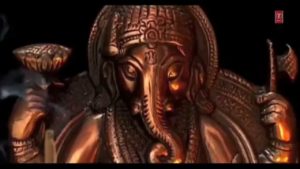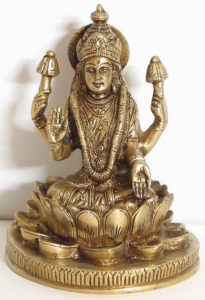The nine spiritually enlightened sons of ‘Hrishabha’, the King of Ayodhya, known as ‘Navayogis’ (Nine ascetics), were constant travelers. During their sojourn, they reached the confluence of the rivers ‘Bagmathi’ and ‘Gantaki’ from where the eldest son, Kavi, got a Salagrama of Vishnu. Salagramas are stones found in the Gantaki river basin in Nepal, with special marks like spiral, chakras, thread, etc. formed on them and considered as sacred with the presence of God Vishnu. “Install this Salagrama at the most holy place for the welfare of mankind”, Kavi heard an ‘asareeri’ ( the divine prompting voice).
Salagramas are stones found in the Gantaki river basin in Nepal, with special marks like spiral, chakras, thread, etc. formed on them and considered as sacred with the presence of God Vishnu. “Install this Salagrama at the most holy place for the welfare of mankind”, Kavi heard an ‘asareeri’ ( the divine prompting voice).
Kavi travelled all over India in search of the befitting place for the installation of the salagrama and placed it on the north bank of Bharatappuzha at Thirunavaya, where Vishnu himself, whom the salagrama represented, had stayed during a ‘Yaga’ conducted by Brahma on the South bank. Kavi left the place complacent that his duty was over, but the salagrama sank into the earth. Then his seven brothers brought other salagramas of Vishnu and repeated the process and these also sank deep into the earth.
At last, the youngest of the brothers, Karabhajanan, came to the same place and knew of the futile attempts of his brothers. He knew that this happened because, the proper rituals that should have been performed at the time of the installation were not performed. He installed the Salagrama, as Mukunda bestowing ‘Moksha’ to the departed souls with all necessary rituals. This time the installation was successful. Later these nine brothers (Navayogis) came to this place and performed a ‘Yaga’ (or ‘Yajna’, meaning ‘ritual of sacrifice’) for the appeasement of the gods and the welfare of the people. The place was thus known as ‘Tirunavayogi’, in memory of the nine brothers, and the word transformed, as time passed, to the present form ‘Thirunavaya’.
 This temple, ‘The Navamukunda Temple’ is one of the oldest Vishnu temples in Kerala. It dates back to the last period of the ‘Dwaapara Yuga’.The main daily offerings for worship are Ney Vilakku (lamp lighted with ghee), Thaamara maala ( Lotus garlands) and Paal paayasam (Porridge/Dessert or Kheer made of rice cooked in sweetened milk). For unhindered availability of lotus flowers, one of the Maharajas of Travancore had constructed a vast pond of lotus plants nearby, and donated it to this temple.
This temple, ‘The Navamukunda Temple’ is one of the oldest Vishnu temples in Kerala. It dates back to the last period of the ‘Dwaapara Yuga’.The main daily offerings for worship are Ney Vilakku (lamp lighted with ghee), Thaamara maala ( Lotus garlands) and Paal paayasam (Porridge/Dessert or Kheer made of rice cooked in sweetened milk). For unhindered availability of lotus flowers, one of the Maharajas of Travancore had constructed a vast pond of lotus plants nearby, and donated it to this temple.
The temple and the surrounding region were under the rule of ‘Cheraman Perumals’ and later under ‘Vettathu Rajas’ who owed allegiance to Perumals. After demise of the last Vettathu Raja in 1793 AD, The British East India Company who, by this time became the rulers of this region, handed over this temple to Kozhikode Samoothiri Raja (the King Zamorin of Calicut) for its administration as ‘Ooraalan’.
Other Deities
Besides the Navamukunda (Vishnu) which is the main deity of the temple, there are two other deities in the Temple: Aadi Ganesa and Sree Mahalakshmi.
Aadi Ganesa
 Indradyumnan, a Pandya King, was a great devotee of Vishnu. When he became aged, he entrusted the administration to his sons and went to the Malayadri Mountains for ‘Tapas’ (self-purifying austerity and penance in lonely place). During his meditation there, he did not know the arrival of ‘Agastya Muni’ who, in uncontrolled anger, cursed Indradyumnan and turned him into an elephant.
Indradyumnan, a Pandya King, was a great devotee of Vishnu. When he became aged, he entrusted the administration to his sons and went to the Malayadri Mountains for ‘Tapas’ (self-purifying austerity and penance in lonely place). During his meditation there, he did not know the arrival of ‘Agastya Muni’ who, in uncontrolled anger, cursed Indradyumnan and turned him into an elephant.
Later on, when Indradyumnan begged him for delivery from the curse, Agastya Muni condescended and said that, Indradyumnan has to wander in the forest as elephant and after many years Vishnu would appear and would deliver him from the curse. When Indradyumnan, the elephant, reached Navamukunda temple, he stayed there worshipping Vishnu every day after taking bath in Bharathapuzha . One day during his bathing in the river Indradyumnan was attacked by a crocodile which was actually a ‘Gandharvan’ named Huhu who had been turned into a crocodile by the curse of a ‘muni’ (ascetic). Indradyumnan prayed Navamukunda to save him and Vishnu appeared on the spot and killed the crocodile with the Sudarsana Chakra and allowed Indradyumna to be seated on his right. Later the ‘Chaitanya’ (divine effulgence) of Lord Ganesa was recognized and Ganesa was installed in the South-West corner of the sanctum sanctorum of the temple.
Sree Mahalakshmi
Aadi Ganesa who was a devotee of Vishnu used to get up early in the morning and pluck lotus flowers from a pond nearby and offer them to Navamukunda every day. On an ‘Akshayathritheeya day’, he did not get any flower, as somebody else had plucked them before his arrival to Pond. He wept before Navamukundan. Navamukundan appeared and told that his wife Sree Mahalakshmi, who had seen what Aadi Ganesa was doing and how much affection Ganesa was getting in return from her husband, wanted to do the same to get as much affection as Aadi Ganesa was getting.
 As Aadi Ganesa continued pleading with Navamukunda for allowing him to carry on plucking of lotus flowers, Navamukunda seated Sree Mahalakshmi on his left so that she may no longer leave to pluck lotus flowers. It is believed that the idol was actually of Mahalakshmi in the form of ‘Dhanalakshmi’- the goddess of wealth- who blessed the people of the region with plenty of wealth and prosperity. Later on Sree Sankaracharya came to the temple and prayed on his knees, not knowing exactly where the other eight Salagramas were lying beneath the earth. Some locals derided him about this. He understood that it was because of the cultural decay that resulted from the too much wealth that made them behave like this. So he struck at the right hand of Mahalakshmi and made it as ‘Abhaya Mudra’. Gradually, people believe, the fiscal powers of the region declined.
As Aadi Ganesa continued pleading with Navamukunda for allowing him to carry on plucking of lotus flowers, Navamukunda seated Sree Mahalakshmi on his left so that she may no longer leave to pluck lotus flowers. It is believed that the idol was actually of Mahalakshmi in the form of ‘Dhanalakshmi’- the goddess of wealth- who blessed the people of the region with plenty of wealth and prosperity. Later on Sree Sankaracharya came to the temple and prayed on his knees, not knowing exactly where the other eight Salagramas were lying beneath the earth. Some locals derided him about this. He understood that it was because of the cultural decay that resulted from the too much wealth that made them behave like this. So he struck at the right hand of Mahalakshmi and made it as ‘Abhaya Mudra’. Gradually, people believe, the fiscal powers of the region declined.
Rituals for the Dead
There are five ‘Yajna’s which are sacred to the Hindus and one of them is Pithrutharpana (Oblation), the prayers for the souls of the departed and rituals involving offering of food and water to the departed. Parasurama (one of the incarnations of Vishnu) is believed to have come here to perform Tharpanam (ritual offerings for the dead) for the souls of the thousands of Kshatriyas he had killed. Because of this, Tirunavaya is considered as one of the most sacred place for conducting rituals for the dead .
 There are several rituals prescribed for the dead. Adiyanthiram, which falls on the 11th day, 16th day or 41st day of death, Sraardham (death anniversary) and Kshethrapindam in which a silver idol into which the soul of the dead is made to enter is brought to the temple as offering after the first anniversary of death, etc are some of the rituals. ‘Bali tharpanam’ is usually performed with Darbha (a type of long grass), Pavithram (ring made of Darbha grass), Ellu (sesame), cooked Rice, Flowers, Sandal paste, Water, etc placed on Banana leaves. An elderly person who knows rituals or a priest leads the ceremonies. Most Hindus of Kerala perform this on the Vavu (no-moon day) in the month of Karkidakam (Zodiac Sign of Cancer) as an ancestral worship or as offering of prayers for the departed souls of their ancestors.
There are several rituals prescribed for the dead. Adiyanthiram, which falls on the 11th day, 16th day or 41st day of death, Sraardham (death anniversary) and Kshethrapindam in which a silver idol into which the soul of the dead is made to enter is brought to the temple as offering after the first anniversary of death, etc are some of the rituals. ‘Bali tharpanam’ is usually performed with Darbha (a type of long grass), Pavithram (ring made of Darbha grass), Ellu (sesame), cooked Rice, Flowers, Sandal paste, Water, etc placed on Banana leaves. An elderly person who knows rituals or a priest leads the ceremonies. Most Hindus of Kerala perform this on the Vavu (no-moon day) in the month of Karkidakam (Zodiac Sign of Cancer) as an ancestral worship or as offering of prayers for the departed souls of their ancestors.
The Pithru tharpanam on Karkkidaka Vaavu is considered as most sacred and important as this Vaavu is very near to the starting period of ‘Dakshinayanam’ (‘going South’ or the starting of the movement of the sun in the southward direction). The idea is connected with the belief that the direction ‘South’ represents the concepts connected with death, because it is YAMA, the God of Death, who rules the South. Most people, who own enough land, bury their dead on the southern side of their residence. In Malayalam, ‘going South’ denotes dying and ‘being taken to South’ denotes burial. Almost equal importance is given to three other Vaavu balis, on the no-moon days of Thulam, Kumbham and Edavom month.
How to reach Navamukunda Temple
By Train: Those coming from the southern districts of Kerala by train, can get down at Kuttippuram Railway Staion and take the road along Tirur for just 7 km.
Those coming by train from the northern districts of Kerala can get down at Tirur Railway Station and travel 12 km along the road to Kuttippuram.
Only some trains (all the ordinary passenger trains and some other trains) have a stop at Tirunavaya Railway Station.
Nearest Airport: Tirunavaya, is connected by good roads to International airports at Kozhikkode (60 km), Kochi (140 km), and Coimbatore (145 km).
https://www.youtube.com/watch?v=gCBC1-KYL8s
Documentery About Thirunavaya Nava Mukunda Temple
Source:thirunavayatemple.org
You may also like
-
India Can’t Afford to Remain Stagnant at this Juncture, Says PM Modi; Asks People to Buy Locally-Made Goods
-
Stolen Artefacts to be Returned to India from Scotland Museums
-
Netaji’s Hologram Statue at India Gate
-
10th Century Stone Idol of Goat Head Yogini IllegallyRemoved from A Temple in Lokhari, Banda, UP Being Returned to India
-
UNESCO Inscribes ‘Durga Puja in Kolkata’ on the Representative List of Intangible Cultural Heritage of Humanity
